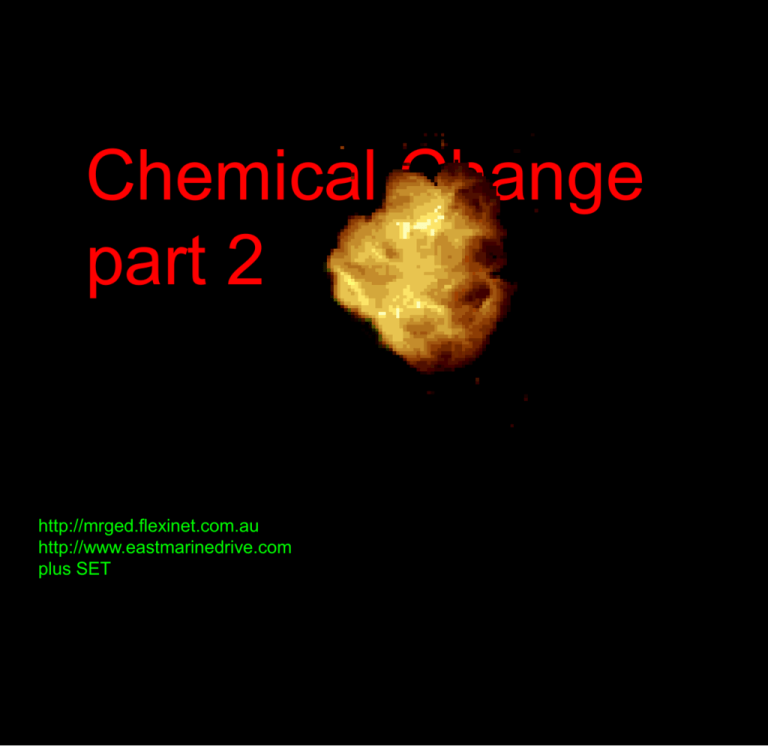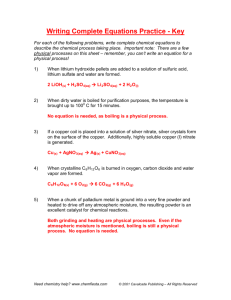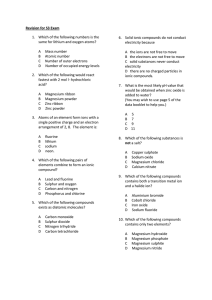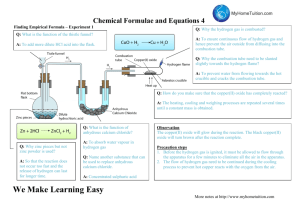lecture 6
advertisement

Chemical Change part 2 http://mrged.flexinet.com.au http://www.eastmarinedrive.com plus SET The Periodic Table Rules leading to correct formula 2. Positive ions usually form the first part of the name (99% cases) 3. If the formula is correct there is no overall charge 4. If you have more than one polyatomic ion it is placed inside brackets Please copy into your exercise books 1. Positive ions (cations) can join to negative ions (anions) + 1 sodium Na potassium K hydrogen H silver Ag lithium Li ammonium NH4 magnesium Mg calcium Ca barium Ba zinc Zn +2 copper Cu +3 iron(11) Fe aluminium Al chromium Cr iron(111) Fe Negative ions (Anions) - 1 fluoride F bromide Br chloride Cl hydroxide OH nitrate NO3 nitrite NO2 hydrogencarbonate HCO3 -2 carbonate CO3 sulphide S oxide O sulphate SO4 Essential training ions Positive ions (Cations) sulphite SO3 chromate CrO4 - 3 nitride N phosphate PO4 NaF The easy way to NaBr learn these! NaNO3 NaHCO3 NH4F NH4Cl NH4OH (NH4)2CO3 (NH4)2S N.B. all numbers should be lowercase and subscript Repeat this process linking each positive to each negative ion Chemical Formulae IONS CHARGES Ca HCO3 FORMULA calcium hydrogencarbonate NUMBERS Chemical Formulae IONS CHARGES Pb PO4 FORMULA lead(11) phosphate NUMBERS Chemical Formulae IONS CHARGES NH4 Cr2O7 FORMULA ammonium dichromate NUMBERS Try these: 1. lithium sulphite 2. barium hydroxide 3. copper carbonate 4. hydrogen sulphide 5. magnesium nitride 6. ammonium bromide 7. aluminium oxide. Li2SO3 Ba(OH)2 CuCO3 H2S Mg3N2 NH4Br Al2O3 In chemistry there are millions of chemical reactions. But most reactions can be classified as one of four types of reactions: Synthesis (Composition) In a synthesis reaction (also known as a composition reaction), two substances combine to form a larger substance. C + O O O C O Here are 3 synthesis reactions: Hydrogen + oxygen yields water 2H2 + O2 -> 2H2O Magnesium + nitrogen yields magnesium nitride 3Mg + N2 -> Mg3N2 Iron + sulphur yields iron(II) sulphide Fe + S -> FeS Write balanced chemical equations for the following synthesis reactions hydrogen + chlorine --------> hydrogen chloride sodium + oxygen -----------> sodium oxide nitrogen + hydrogen --------------> H2 + Cl2 --------> 2HCl 4Na + 02 -------> 2Na2O 3H2 + N2 -------> 2NH3 ammonia ANSWERS UNDER HERE Mr G Decomposition In a decomposition reaction, a larger substance breaks apart and forms two or more simpler substances. The first thing you may notice about a decomposition reaction is that it is the complete opposite of a synthesis reaction. In fact many synthesis reactions can be reversed into a decomposition reaction. When you burn hydrogen gas, the hydrogen combines with oxygen to produce water. 2H2 + O2 -> 2H2O With an electrical current, water can be decomposed into hydrogen and oxygen gas. 2H2O -> 2H2 + O2 Some examples of decomposition Heat copper carbonate and it will decompose (Refer to flash animation .swf) CuCO3 -> CuO + CO2 (Most carbonates decompose producing the oxide and carbon dioxide) Heat lead(11) hydroxide and it will decompose Pb(OH)2 -> PbO + H2O Write balanced chemical equations to show the following decompositions, heat copper oxide + steam copper hydroxide -------> heat sodium nitrate ---------> sodium nitrite + oxygen heat mercury(1) oxide ------> mercury + oxygen heat zinc nitrate ------> zinc oxide + nitrogen dioxide + oxygen heat calcium carbonate -------> calcium oxide + carbon dioxide Solutions QUESTION SOLUTIONS UNDER HERE Cu(OH)2 ------> CuO + H20 2NaNO3 ------> 2NaNO2 + 02 2Hg2O --------> 4Hg + O2 2Zn(N03)2 ------->2ZnO +4NO2 + O2 CaCO3 --------> CaO + CO2 Single Replacement In a single replacement reaction, a more active element replaces a less active element in a compound. more reactive less reactive Single Replacement Here Mg is more reactive than Pb Single Replacement If fluorine gas is bubbled through a solution of potassium chloride, the fluorine will replace the chlorine. This reaction can be represented as follows; 2KCl + F --> 2KF + Cl No surprise! fluorine is more reactive than chlorine Write balanced chemical equations for the following single replacement reactions magnesium + hydrochloric acid --->hydrogen + magnesium chloride bromine + hydrogen iodide ---> hydrogen bromide + iodine lithium + copper sulphate -----> lithium sulphate + copper fluorine + sodium chloride ----> sodium fluoride + chlorine zinc + nitric acid -----> zinc nitrate + hydrogen Solutions here! Mg + 2HCl ------> MgCl2 + H2 Br2 +2HI ------> 2HBr + I2 2Li + CuSO4 ------> Li2SO4 + Cu F2 + 2NaCl -------> 2NaF + Cl2 Zn + 2HNO3 -----> Zn(NO3)2 + H2 A double replacement change Br H Na O + Mg O Na H Br What is reacting with what? Look at arrows how do they rearrange? Double Replacements H O Na Br Mg + Na O H Br Products from previous page The whole chemical reaction N a Br Mg O O O H + H Mg + H Br N a N a O Br H + Br N a Mg(OH)2 + 2NaBr --> MgBr2 + 2NaOH Notice the atoms or ions are just rearranged The number of atoms on both sides of arrow are the same Now write equations for the following double replacement reactions ? = unknown part silver + nitrate copper sulphate ? sodium chloride sodium + ? + ? ? chloride ? + nitrate copper hydroxide lead iodide + + ? nitrate potassium nitrate











